The chrysanthemum has long been admired as a bloom of much significance in several cultures, particularly their native homeland, China. It is a genus with amazing diversity, both in blooms and uses. These unique plants are equally useful in the kitchen (teas, soups, salad greens, etc) as they are in combating garden pests (mums are a key ingredient in the organic insecticide, Pyrethrum). Often called “the golden flower”, their blooms are infused with folklore the world over. Most importantly, to me at least, is that they make a very tough and long lasting cut flower.

Unfortunately, mums as cut flowers in the United States suffered quite a blow when flower production was globalized in the 70s and 80s. As flowers became bred to withstand long distance shipping and rough handling in super markets, the thousands of unique mum cultivars available got nit picked over until only a handful of super sturdy (boring) button mums and even fewer “football” mums remained in mass production for cutting. You’ve probably wrinkled your nose at the idea of mums in any bouquet other than the ones you grab at the market while shopping for dinner ingredients.
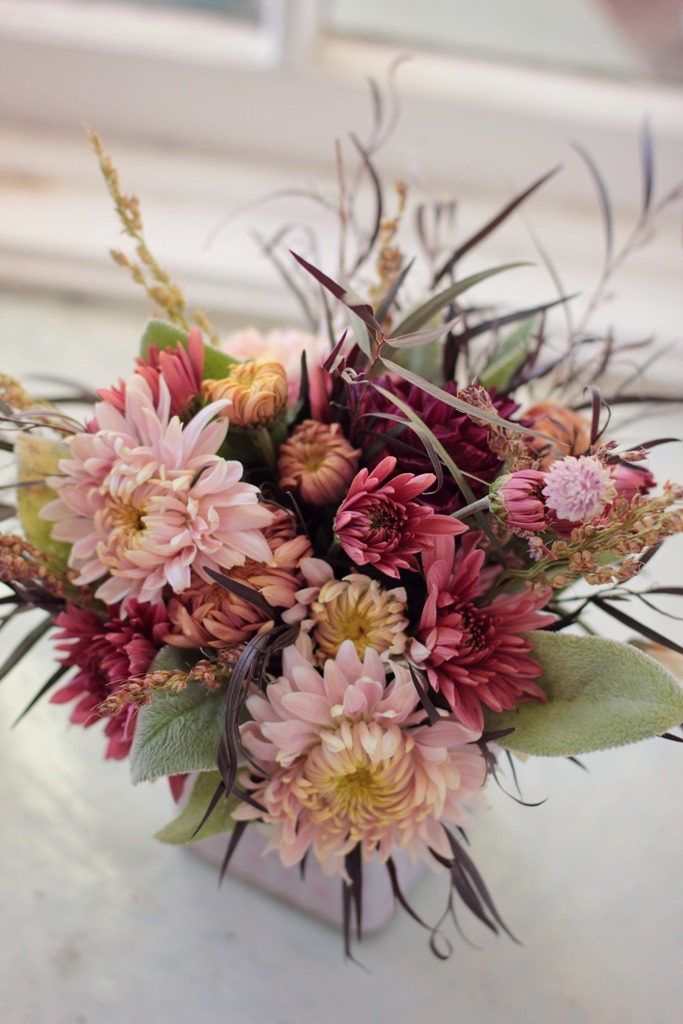
I have to confess that I was most decidedly in the anti-mum camp for most of my life. I never really found them pretty. While working at Longwood Gardens, one of the most renown hubs for mum production in the US, I learned the fine art of disbudding and pinching for highest quality blooms. It was there that I first saw a catalog from King’s Mums. I thumbed through and became fascinated by all the different bloom classifications. Even while loathing the many (many!) hours of disbudding in the greenhouse, I was incredibly inspired by their beauty and the idea of re-introducing the more unique heirloom cultivars into the cut flower industry.

As I began growing and designing for more and more weddings, many in the late weeks of autumn with the risk of frost ever present, I knew heirloom mums were the answer. These hardy blooms can handle light frost without flinching and many have the same dramatic beauty of dahlias. If grown under the cover of a hoop house, they can easily keep blooming well through Thanksgiving here in Philadelphia. Each plant is hugely productive so a small amount goes a long way. Our November weddings and Thanksgiving centerpieces are heavily reliant on the mums. Now in the fourth season of mum production at the farm, I feel like I’ve got a good handle on which varieties work best, particularly for wedding designs.
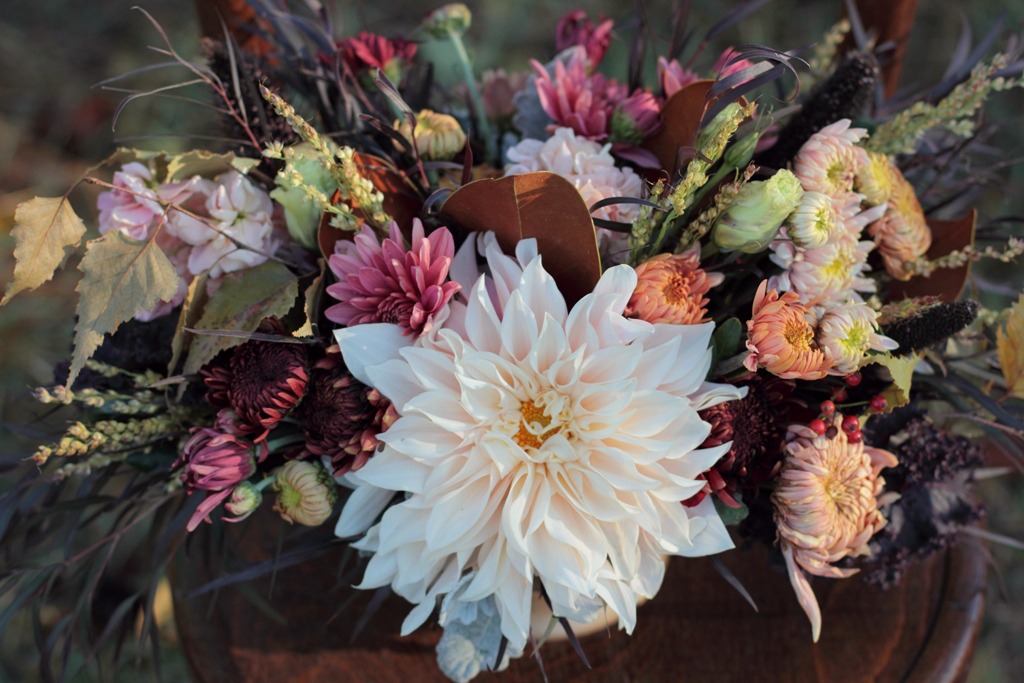
~~~~~~~~~~
Favorite Varieties
All of the following are available from King’s Mums.
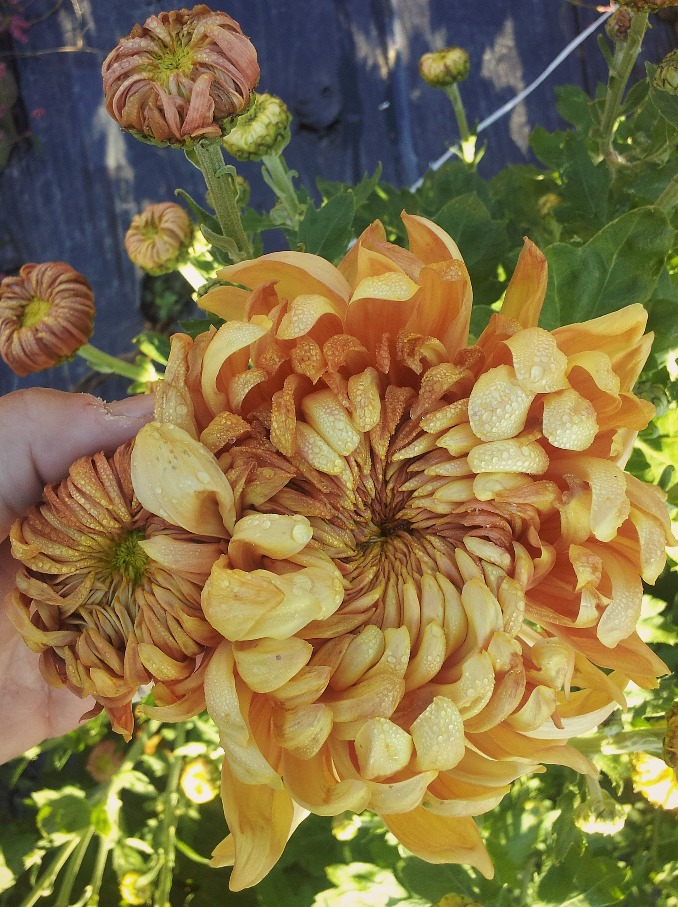
1) Apricot Alexis
Absolutely my number one favorite mum of all time! Possibly one of my top five favorites of any flowers, particularly for wedding designs! This large lush bloom has the most amazing copper gold tone. You can do no wrong as a designer when Apricot Alexis is at your disposal. It’s a very productive plant and does fairly well without disbudding, though it would no doubt do better if you took the time to do so. Since the central bud opens so much earlier than the laterals, we usually cut it out first to use in small centerpieces. The main stems of the plant are thick and super sturdy so they hold up well to being out in the open field. Light frost can damage opening buds though so if you can protect them, do so. Apricot Alexis would surely be an excellent crop for growers selling to high-end event florists. There is one tragic downside to Apricot Alexis that is important to note. Apparently she’s a finicky plant that doesn’t like to overwinter so the team at King’s Mums has a hard time getting enough cuttings to sell. It may not be available in 2014. I’m saving cuttings of my own in desperation.
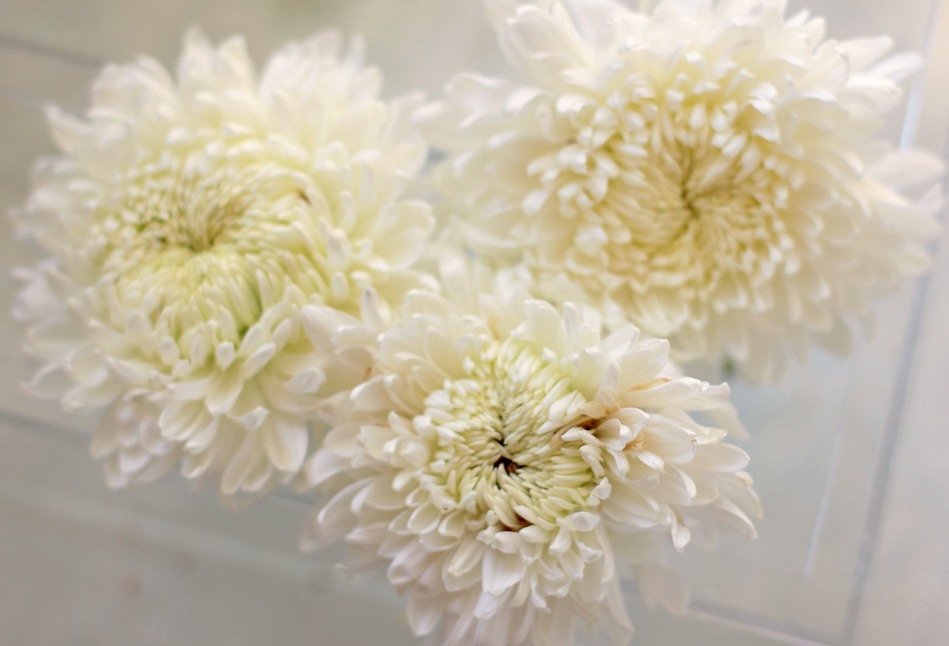
2) Lynn Johnson
A large lush white irregular incurve that blooms early on tall stems. It’s super productive and the best of the many whites I’ve tried over the years. Great for bridal bouquets and centerpieces alike. It does well grown as a spray out in the open field. Aphids are a big problem on these though so plan accordingly.
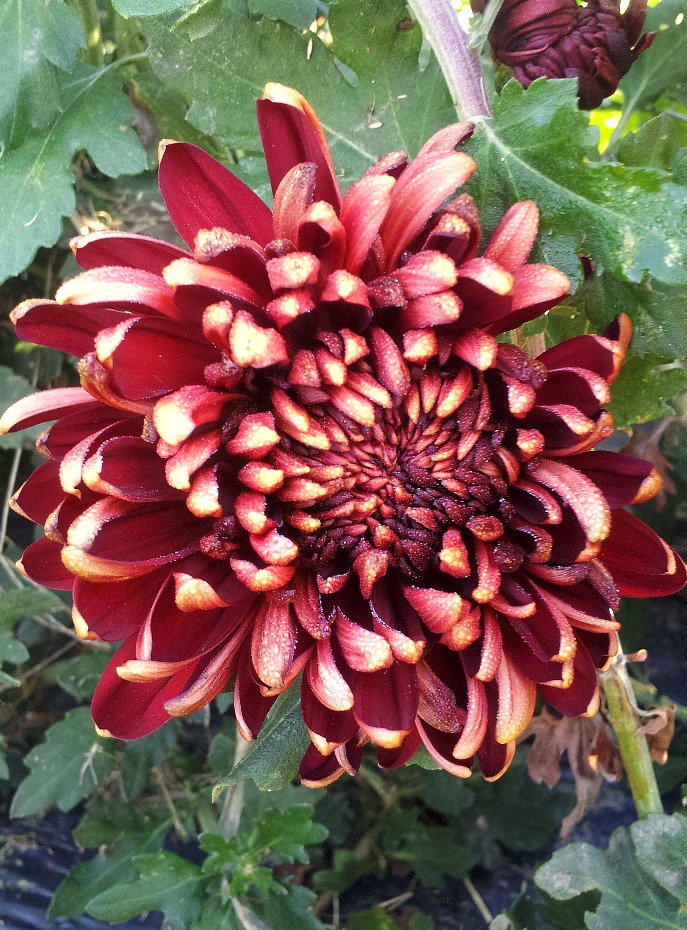
3) Candid
My second favorite mum of all time, the rich ruby red of this bloom is unlike any other I’ve seen. It’s a red that actually works wonderfully for weddings. It’s a striking accent in centerpieces, and I love to pair it with warm soft pinks and peach blooms along with purple kale. A very reliable producer, it’s great grown as a spray with long enough laterals that you can split the main stem apart to use smaller side stems in centerpieces. Buds are also great in boutonnieres.
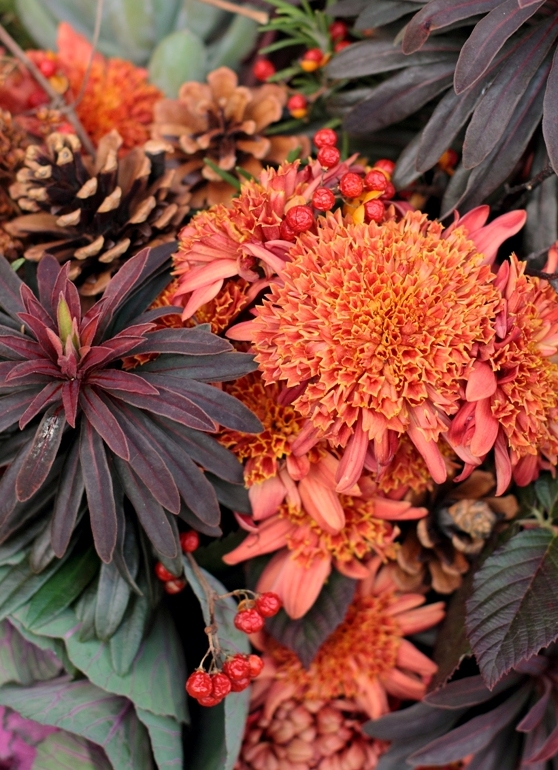
4) Seatons Ruby
One of the only flowers I know that displays a true gold quality at the tip of its petals. When fully open, it has a large cushion in the middle. We often use it before it’s fully open though and absolutely love the very warm red and gold color mixed in with other warm autumn tones. Flowers very nicely as a spray. Buds are especially cute for boutonnieres.
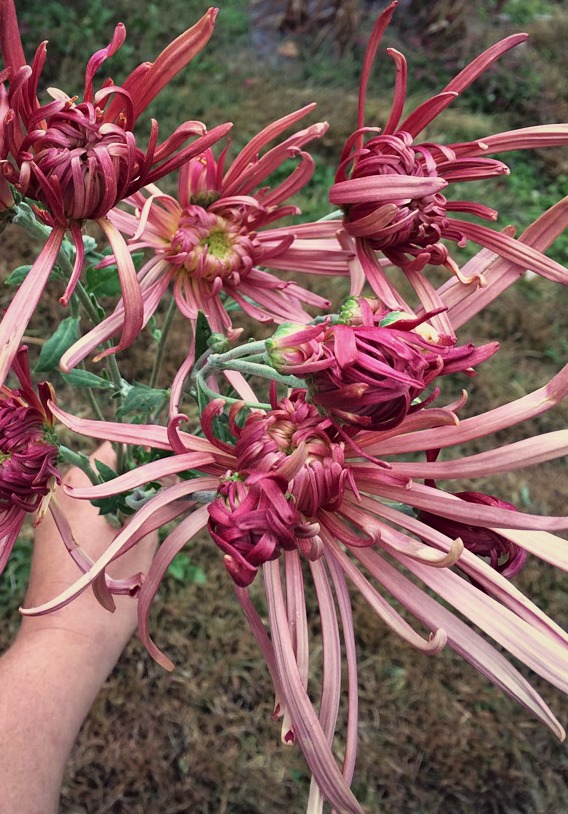
5) Mocha
Spider mums are incredibly unique but sometimes tricky to use in wedding floral designs. Mocha’s soft toffee color helps it bridge the gap between weird/funky and elegant. My favorite time to use it is actually when the blooms are about half open so it looks more like a quill than a spider. The little curled ends of the petals are incredibly precious. The plant is very productive and with nice long slender uniform stems. Those slender stems do mean that it’s prone to toppling in heavy storms. Mocha would be best in a hoop house.
6) Apricot Courtier
A new cultivar to us this year, but firmly in the favorites list and definitely a repeat, this very warm peachy gold bloom is superb for wedding work. The buds are large and nicely colored for personal pieces like boutonnieres, corsages and hair flowers. The full bloom is large and lush with coloring that pairs beautifully with Seatons J Dore, Honeyglow, and anything orange.
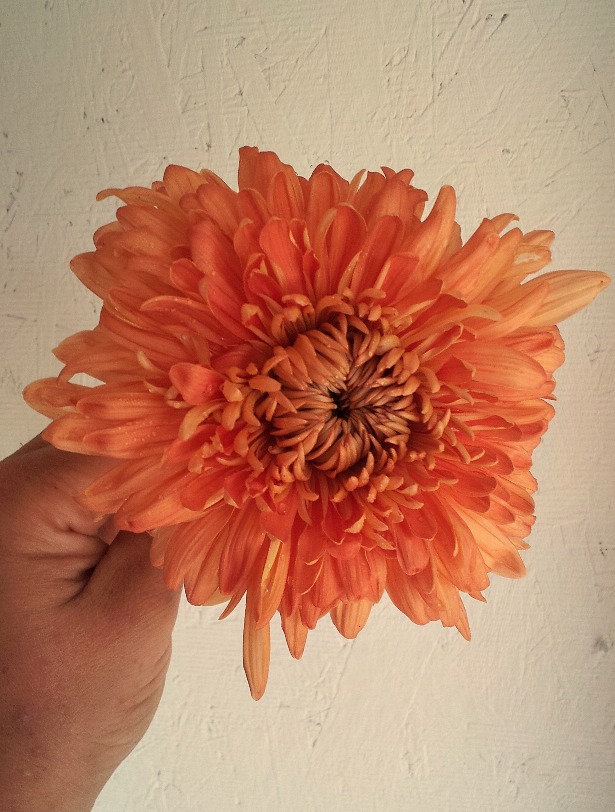
7) Honeyglow
Your classic orange mum, Honeyglow is ridiculously productive and easy to grow. It’s a definite “must” for anyone growing for autumn farmers markets or wholesale. Stems are long and it grows wonderfully as a spray with all the blooms at pretty much the same level on each stem. The color is a really nice warm tone so it mixes nicely with Candid and Seatons Ruby for autumn centerpieces. It is an early bloomer so if you’re considering it for Thanksgiving sales, make sure you have a cooler so you can hold it a week or two if needed. Like all mums, it’s got a very long shelf life.
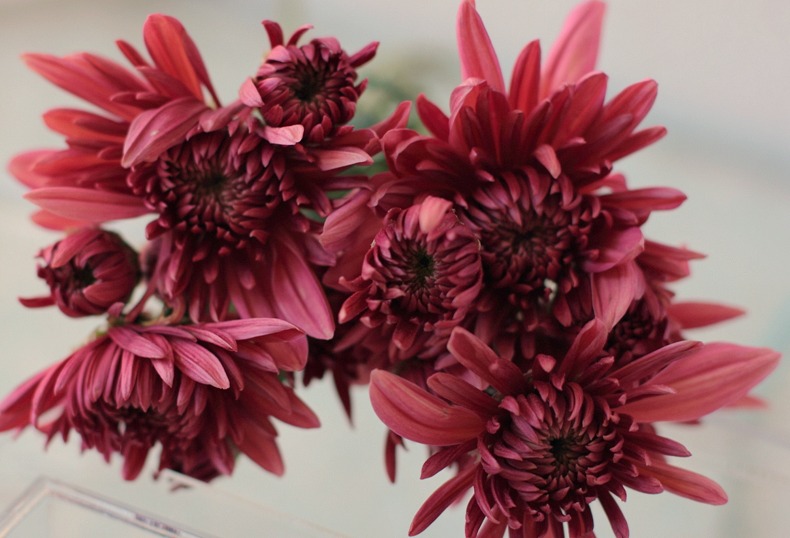
8) Coral Charm
Always a looker and highly productive, this little beauty tends to bloom more warm mauve than coral for us (see above photo). It’s really a great color though for fall and I prefer it to a true coral anyway. It’s super productive and great grown as a spray. Wonderful for centerpieces with hefty blooms that make designing quick. The warm undertone of the color lets it play nicely with other warm autumn colors, even red. This cultivar has been at the farm since we started growing mums and will be there until we stop. Definitely a keeper!
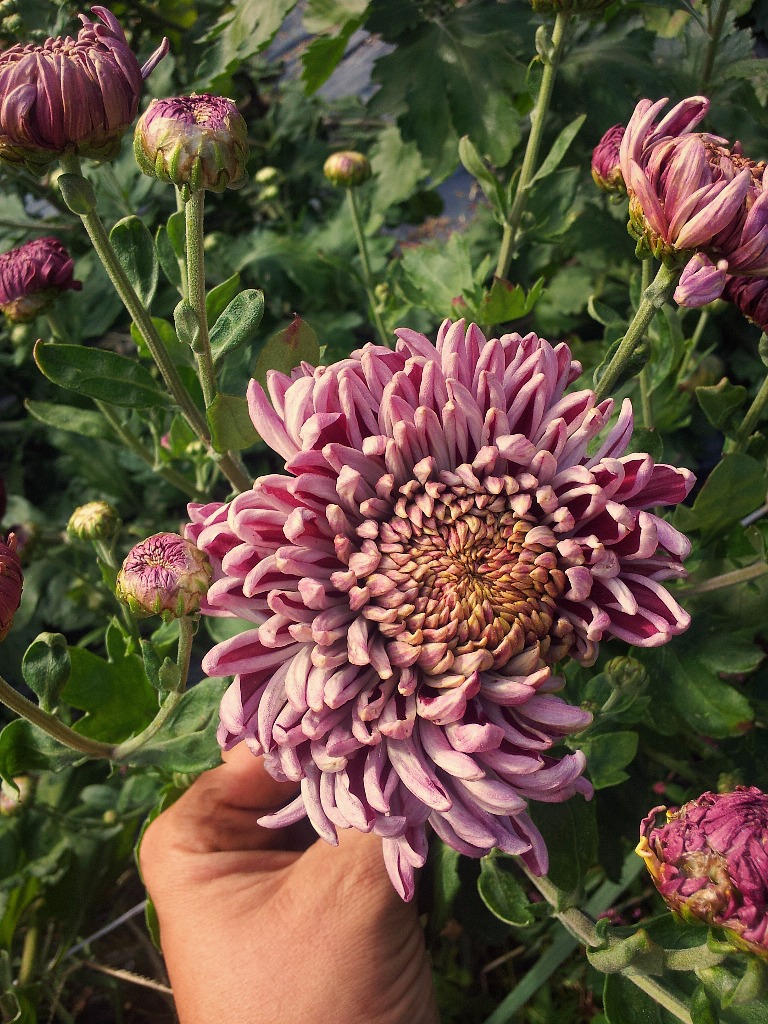
9) Moira
This dusky purple flouncy bloom was new to us this year. It’s definitely staying in the rotation. The buds are huge and a true purple; great for corsages and boutonnieres. As the petals open, they soften to a lavender tone that is beyond lovely when mixed with Candid and Apricot Alexis, as well as late season dahlias like Cafe au Lait and Voodoo. The plants were not particularly robust for us so Moira may not be the best cultivar for growers focused on wholesale production. It’s worth it though if you’re a farmer florist looking for that perfect warm purple bloom for your autumn bridal bouquets.

10) Seatons J Dore
You’ll never find a pink quite like this. So very delicate, it is a warm hue that blends superbly with the classic red and copper tones of autumn. Mix a few of these in with Apricot Alexis and Candid in a bouquet or centerpiece for instant drama and color harmony. Very productive with long slender stems. Best grown under cover if you can but perfectly fine out in the field too.
Growing Notes
Our rooted cuttings from King’s are grown on in four inch pots in the heated greenhouse from March through May. As the plants grow, they are pinched at about four or five inches tall. The pinched piece gets dipped in rooting hormone (also available from King’s Mums) and then rooted on a heating mat in a deep plug tray. These newly rooted cuttings also get pinched as they grow . . . and so the cycle continues so we have a massive number of plants by the time we plant them out in the field (usually the first week of May).
Our mums are grown in black plastic with drip irrigation. Spacing is 12″ apart, two rows in a three foot wide bed. Mums are ideally supported with two levels of Hortnova netting, though if plants get too big before we get around to putting netting on, they get supported with stakes and twine. Harvesting through the netting is tough so I’m still weighing the pros and cons of different supports for cut production.
The plants get a second hard pinch in July, pinching all the branches down to about two sets of leaves to encourage even more branching. If we wanted earlier bloom production for some reason, we would not do this second pinch.
We do not disbud at the farm. It’s too labor intensive for our small operation/team. Instead, two hard pinches prove to be sufficient for getting nice blooms for wedding work. There are many blooms on each main stem, but we can cut each large cluster apart and use the shorter side stems in centerpieces. This system works for us but may not work for every farm depending on the end consumer.
Our mums are grown organically so we use a combination of fish emulsion, kelp and compost tea sprayed as a foliar feed every other week throughout the growing season until they begin to bloom.
Most of our mums are field grown, but about 25-30 plants go into the hoop house as well. When we have more hoop house space, we’ll grow many more inside as wind and rain are hard on mums. But mums can definitely do well out in the open field if you don’t have a hoop house.
The only major pest we’ve really experienced on the mums to date are aphids. They are quite abundant, and we use Pure Spray Green as an organic control. Regular sprays are important as buds begin to form since the aphids like to snuggle down in the unfolding petals. White mums seem to be especially prone to aphid pressure.
We are cutting heavily from the mums from the last week of October to the third week in November.
We have overwintered mums in the hoop house with pretty solid success. If the winter is mild, the ones in the field will overwinter as well. If it’s cold, they don’t make it. Here in zone 7 in Philadelphia, we don’t rely on overwintering and just plan to order new plugs each spring.

Great post and beautiful images, thank you for sharing your knowledge with all.
Jennie, thank you for sharing your vast mum knowledge! This is inspiring me to plant mums next year, a flower I have previously written off 🙂
Awesome, Kelly! You should definitely give them a try!!
Thank you so much for posting and sharing this incredible knowledge! i love mums! especially after reading this!! and you never know…maybe next year the dreaded gladiola will make a comeback :))))
Too funny, Betsy! I bet gladiola are gonna make their come back one day! But maybe not next year… 🙂
Thank you for spending the time to demystify mums for me. They are beautiful and I have a feeling King’s Mums will be very busy taking orders.
Thank you Jenny! My mum knowledge is hugely lacking. I have ordered from King’s but my plants are not great. Thank you again for the education! I will try to grow better!
I sure wish I could have worked at Longwood. One of my favorite places.
Hugs!
Hugs to you too, Nancy! Try planting your plants out even earlier under a layer of Agribon for a little protection. Maybe that will get you the number of growing days you need for more blooms. We also fertilize heavily with fish emulsion and kelp. I’ll put that up in the blog post as I forgot to mention it earlier. I would surely think Honeyglow and Lynn Johnson would be good bets for you as they bloom early. xo
What a treasure of knowledge!! Thank you so much for sharing!
these are stunning! we never order mums – but these I want!
I could not love this post more! Hooray for the reintroduction of so many beautiful heirloom varieties, and thank you for encouraging the use of in-season flowers. Gorgeous work…kudos to you!
This is so helpful, thanks! How many cuttings per variety do you start with to propagate from and how many plants do you end up setting out from that number?
Thanks for such an informative post about varieties and growing techniques for these beauties! I felt super lucky to see some gorgeous, exciting mum varieties blooming at Robin Hollow Farm yesterday afternoon. Instead of Hortonova, they were using 10′ long metal concrete reinfocement panels with the long sides bent down at 90 degree angles and then placed over the beds as their growing supports. I’m officially inspired to experiment with growing some mums next season!
I seriously loved this post! You’ve converted me – I’m crazy about mums now!!
Beautiful and inspiring! Here in the UK chrysanths have suffered the same fate, but seeing them grown and displayed like this is proof they are due the same renaissance that dahlias are presently enjoying
Thank you so much for this post. I am a home gardener and this year begin what I know is going to be a love affaire with mums. Your post here was very helpful. I just put up a post on them on my blog nothing to compare with yours, just a little ode to their beauty…all so lovely.
What an informative and beautiful site. One never stops learning and I appreciate your sharing with so many.
Thanks so much for generously sharing all this invaluable information. King’s is just gonna have to ramp up production after this post 🙂
I loved this blog post and bought my farm a large variety from King Mums and I am so sad to hear they won’t be able to have their season this year. Is there another source you recommend?
I know, it’s truly heartbreaking. For anyone who doesn’t know, you can read more here about King’s disruption of stock: http://myemail.constantcontact.com/2014-Shipping-Announcement.html?soid=1109510086072&aid=HBn2fE54XTE
I do not have any other mum suppliers that I have used, but you can be sure I’m currently on the hunt for some. I will update the post if I should find some.
I just got my order from the new King’s Mums and was so excited to come back and revisit your post to see what I should do with my plugs. I was also thrilled to see I chose so many of the cultivators you mentioned above. I think I a might need to grab a few more I missed. Thanks again for all the great info.
Hi there! What a beautiful site! I would love to grow Moira Chrysanthemums in my garden (from being swayed by the pictures on this page!) wondering if you sell seeds or plants at all? I’m in Michigan!
Thanks!
Would you consider selling a few rooted cutting next spring?thanks
I’m afraid we no longer grow mums at our farm and so we don’t have any cuttings.
Hi Jennie!
Just wondering what kind of medium you plant the mum cuttings in? I am getting many different results while researching online and am just wondering what worked best for you?
Thanks!
I use potting soil — ProMix BX to be exact. 🙂 Hope that helps!
Great post! Thanks a ton for sharing-while I was reading it I had to keep getting up and walking around because I was too exited to sit. I’m in Colorado in zone 5. Really helpful to know good varieties and that you don’t disbud. Hope you have a great 2019 season!
Would you say in zone 7 late March it would be okay to plant out rooted cuttings from King’s in low tunnels due to cramped indoor space?
If you put several layers of frost cloth (Agribon/Remay) over them, supported by low hoops so the fabric doesn’t touch the small plants, then, yes, they should be okay. But if you haven’t already, make sure to put those cuttings up and let them have a week or two to get acclimated. Usually rooted cuttings aren’t as robust as a typical baby transplant so they’ll need a little time in a pot first before planting out in the field. Otherwise you may experience a high mortality rate due to root rot, rather than frost.
Jennie,
Have you re-thought your support system for your mums yet or are you still using the netting? I’m wondering if corralling would make harvesting a bit easier and still would hold them up. I”m speaking for mums out in the field.
Thank you,
Patty
Hi Patty – I’ve actually stopped growing mums because I decided I wanted to wrap up my season at the end of October each year, rather than push through to Thanksgiving. I loved having the mums, but I needed to find a better balance in my life so I decided to shave a few weeks off my sales and have a little more peace and quiet in my life. 🙂 That being said, I think corralling the mums would work fine. I do that with my dahlias and far prefer it over the netting!
I think this is fabulous, like Peonies of the fall. Beautiful.
Well, thanks to you I tried mums this year — thanks for that, btw — and the first few blooms of “River City” and “Golden Rain” are staring to unfurl. Problem is, they fell over while I was on vacation a few months back and when I returned I was afraid of breaking them off, so they just kept growing all sprawled over each other.
I grew them in containers, anticipating the need to bring them in during freezes, but I don’t know if that’s even possible now.
And of course they’re forecasting a dip down to 31F in a few nights.
If I bundle them up in a few layers of frost blanket, will that be enough to save the blooms, d’you think?
What is the best source to purchase kings mum seed or plants?
Hi Kim – From King’s Mums.